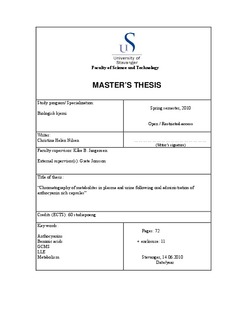| dc.description.abstract | Anthocyanins (ACs) are powerful antioxidants widely distributed in fruits and vegetables.
Several international studies suggest that anthocyanins have positive effects on the health,
including various chronic diseases. To be able to study the possible anthocyanin mechanisms
in the human body, it is of importance to know their metabolism. MEDOX® is an AC rich
product made from bilberries and blackcurrant and consists of 17 different anthocyanins with
delphinidin-3-O-β-glucopyranoside and cyanidin-3-O-β-glucopyranoside as the main
constituents. There are only 5 different aglycone structures of these 17 anthocyanins;
delphinidin, cyanidin, peonidin, petunidin and malvidin. An extensive metabolism of ACs is
indicated following oral administration of this supplement. Free and conjugated benzoic acids
(BAs) with functional groups corresponding to the anthocyanin B-ring structure have been
recognized as metabolites in urine and plasma. Correspondingly, gallic acid, protochatechuic
acids, vanillic acid, syringic acid and 3, 4-dihydroxy-5-methoxybenzoic acid have been
suggested as metabolites of delphinidin, cyanidin, peonidin, malvidin and petunidin
respectively. Hydroxy benzoic acids are relatively polar compounds, and derivatization is
therefore usually necessary prior to gas chromatography mass spectrometry (GCMS) analysis.
The objective of this thesis was to develop a robust analytical method for determination of
these BAs in addition to 4-hydroxybenzoic acid which is a suggested metabolite of the AC
pelargonidine. Liquid-liquid extraction (LLE) was chosen as the best sample extraction
method as compared to solid phase extraction (SPE) and solid phase analytical derivatization
(SPAD) with respect to recovery, reproducibility and sample purity. LLE was also less time
consuming than SPE. The recoveries of BAs in urine ranged from 62 – 121 %, and recoveries
in plasma from 37 – 158 %. All BAs were identified and quantified in urine and plasma after
oral administration of MEDOX® in increased levels compared to before intake. All
metabolites were detected as both free BAs and in conjugated form linked with glucuronic
acid, in both urine and plasma. Results obtained from the work of this thesis suggest that the
ACs in this product metabolize to their corresponding BAs. | en_US |
